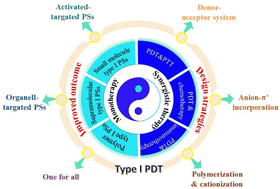Recent advances in type I organic photosensitizers for efficient photodynamic therapy for overcoming tumor hypoxia
Abstract
Photodynamic therapy (PDT) with an oxygen-dependent character is a noninvasive therapeutic method for cancer treatment. However, its clinical therapeutic effect is greatly restricted by tumor hypoxia. What's more, both PDT-mediated oxygen consumption and microvascular damage aggravate tumor hypoxia, thus, further impeding therapeutic outcomes. Compared to type II PDT with high oxygen dependence and high oxygen consumption, type I PDT with less oxygen consumption exhibits great potential to overcome the vicious hypoxic plight in solid tumors. Type I photosensitizers (PSs) are significantly important for determining the therapeutic efficacy of PDT, which performs an electron transfer photochemical reaction with the surrounding oxygen/substrates to generate highly cytotoxic free radicals such as superoxide radicals (˙O2−) as type I ROS. In particular, the primary precursor (˙O2−) would progressively undergo a superoxide dismutase (SOD)-mediated disproportionation reaction and a Haber–Weiss/Fenton reaction, yielding higher cytotoxic species (˙OH) with better anticancer effects. As a result, developing high-performance type I PSs to treat hypoxic tumors has become more and more important and urgent. Herein, the latest progress of organic type I PSs (such as AIE-active cationic/neutral PSs, cationic/neutral PSs, polymer-based PSs and supramolecular self-assembled PSs) for monotherapy or synergistic therapeutic modalities is summarized. The molecular design principles and strategies (donor–acceptor system, anion–π+ incorporation, polymerization and cationization) are highlighted. Furthermore, the future challenges and prospects of type I PSs in hypoxia-overcoming PDT are proposed.

- This article is part of the themed collections: 2023 Journal of Materials Chemistry B HOT Papers and Journal of Materials Chemistry B Recent Review Articles


 Please wait while we load your content...
Please wait while we load your content...